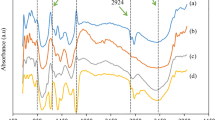Abstract
To compare with pyrolysis characteristics of cellulose from moso bamboo and poplar, samples were pyrolyzed with different heating rates through thermogravimetric analysis (TG). The kinetics was calculated by Kissinger–Akahira–Sunose method. The results showed that pyrolysis process of moso bamboo and poplar fiber included three stages, and the main pyrolysis occurred in the second step. Moso bamboo fiber had a higher start temperature, a lower end temperature and a more mass loss at each heating rate in the main pyrolysis stage. With increase in heating rate, the temperature corresponding to the maximum of mass loss increased and the DTG curve shifted to higher temperature. The reaction rates varied at different heating rates. The activation energy of cellulose from moso bamboo was lower than poplar cellulose, indicating cellulose of moso bamboo was easier to be pyrolyzed. The results from this research will provide guidance to thermal conversion of moso bamboo and poplar.



Similar content being viewed by others
References
Gottipati R, Mishra S. A kinetic study on pyrolysis and combustion characteristics of oil cakes: effect of cellulose and lignin content. J Fuel Chem Technol. 2011;39:265–70.
Wang J, Chen M, Zhang MX, Min FF, Chen MG. Three kinds of biomass pyrolysis dynamics research. J Harbin Instit Technol. 2009;41:180–3.
Wilk M, Magdziarz A. Hydrothermal carbonization, torrefaction and slow pyrolysis of Miscanthus giganteus. Energy. 2017;140:1292–304.
Rath J, Steiner G, Wolfinger MG. Tar cracking from fast pyrolysis of large beech wood particles. J Anal Appl Pyrolysis. 2002;62:83–92.
Branca C, Di Blasi C. A unified mechanism of the combustion reactions of lignocellulosic fuels. Thermochim Acta. 2013;565:58–64.
Ozawa T. A new method of analyzing thermogravimetric data. B Chem Soc Jpn. 1965;38:1881–6.
Friedman HL. New methods for evaluating kinetic parameters from thermal analysis data. J Polym Sci Polym Chem. 1969;7:41–6.
Sánchez JD, Ramírez GE, Barajas MJ. Comparative kinetic study of the pyrolysis of mandarin and pineapple peel. J Anal Appl Pyrolysis. 2016;118:192–201.
Jeguirim M, Bikai J, Elmay Y, Limousy L, Njeugan E. Thermal characterization and pyrolysis kinetics of tropical biomass feedstocks for energy recovery. Energy Sustain Dev. 2014;23:188–93.
Rocha EPA, Sermyagina E, Vakkilainen E, Colodette JL, Oliverira LM, Cardoso M. Kinetics of pyrolysis of some biomasses widely available in Brazil. J Therm Anal Calorim. 2017;130:1445–54.
Wang J, Chen M, Zhang MX, Min FF, Chen MG. Kinetic study on thermolysis of three different biomass species. J Harbin Inst Technol. 2009;7:187–90.
Shih YF. A study of the fiber obtained from the water bamboo husks. Bioresour Technol. 2007;98:819–28.
Liu X, Yu W. Evaluating the thermal stability of high performance fibers by TGA. J Appl Polym Sci. 2006;99:937–44.
Wang LL, Zhang DS, Hong Z. An analysis on the characteristics of pyrogenation and carbonization shrinkage of bamboo timber. J Bamboo Res. 2005;3:034–8.
Wan X, Jiang X. Comprehensive utilization of bamboo surplus material by processing. Technol Dev Enterp. 2006;7:073–5.
Lin SZ, Zhang ZY, Zhang Q, Lin YZ. Progress in the study of molecular genetic improvements of poplar in China. J Integr Plant Biol. 2006;48:1001–7.
Fang SZ. Silviculture of poplar plantation in China: a review. J Appl Ecol. 2008;19:2308–16.
Stefanidis SD, Kalogiannis KG, Iliopoulou EF, Michailof CM, Pilavachi PA, Lappas AA. A study of lignocellulosic biomass pyrolysis via the pyrolysis of cellulose, hemicellulose and lignin. J Anal Appl Pyrolysis. 2014;105:143–50.
Garcia-Maraver A, Perez-Jimenez JA, Serrano-Bernardo F, Zamorano M. Determination and comparison of combustion kinetics parameters of agricultural biomass from olive trees. Renew Energy. 2015;83:897–904.
Mani T, Murugan P, Abedi J, Mahinpey N. Pyrolysis of wheat straw in a thermogravimetric analyzer: effect of particle size and heating rate on devolatilization and estimation of global kinetics. Chem Eng Res Des. 2010;88:952–8.
Anca-Couce A, Berger A, Zobel N. How to determine consistent biomass pyrolysis kinetics in a parallel reaction scheme. Fuel. 2014;123:230–40.
Kim SS, Kim J, Park YH, Park YK. Pyrolysis kinetics and decomposition characteristics of pine trees. Bioresour Technol. 2010;101:9797–802.
Shen DK, Gu S. The mechanism for thermal decomposition of cellulose and its main products. Bioresour Technol. 2009;100:6496–504.
Agrawal A, Chakraborty S. A kinetic study of pyrolysis and combustion of microalgae Chlorella vulgaris using thermo-gravimetric analysis. Bioresour Technol. 2013;128:72–80.
Khawam A. Application of solid-state kinetics to desolvation reactions. 2007.
Magdziarz A, Wilk M, Straka R. Combustion process of torrefied wood biomass. J Therm Anal Calorim. 2017;127:1339–49.
Ceylan S, Topçu Y. Pyrolysis kinetics of hazelnut husk using thermogravimetric analysis. Bioresour Technol. 2014;156:182–8.
Acknowledgements
This research was financially supported by ‘13th Five Years Plan Study on manufacturing technology of bamboo wastes and its mechanism (Grant No. 2016YFD0600906) and ‘Basic Scientific Research Funds of International Centre for Bamboo and Rattan-Co-firing technology of torrefied bamboo and coal’ (Grant No. 1632016011).
Author information
Authors and Affiliations
Corresponding author
Rights and permissions
About this article
Cite this article
Liang, F., Zhang, T., Xiang, H. et al. Pyrolysis characteristics of cellulose derived from moso bamboo and poplar. J Therm Anal Calorim 132, 1359–1365 (2018). https://doi.org/10.1007/s10973-017-6920-1
Received:
Accepted:
Published:
Issue Date:
DOI: https://doi.org/10.1007/s10973-017-6920-1



